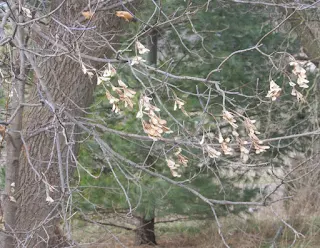 |
| Rose hips. Rosa palustris |
 |
| As always, you can click on the picture to embiggen. Close up of hips. Pretty as rubies. I do not have R. palustris on my property but it is within spitting distance. |
 | |
| Rosa canina |
 |
| Persimmons. Morris Burton is carrying the largest amount of fruit, probably because its fruit is smaller and gravity does not exert as great a tug on the fruit. |
 |
| Close up of fruit. Not all mast shown on this page can be eaten by humans. Both rose hips and persimmons are edible. |
 | |
| Bittersweet Nightshade Solanum dulcamara , not edible. |
 |
| Poke Berries. |
 |
| Box Elder seeds. Acer negundo Not very impressive hard mast, but beggers cannot be choosers. According to Allen Dean Olsen, the seeds can be scorched to minimize the samara (the wingy part) and ground for flour. |
 |
| Black Locust seeds. Not considered edible for humans. |
 |
| Sumac seeds. Considered more of a flavoring than a food. Most of our sumac seeds were eaten early this year by flocks of starlings. |
 |
| Wild grapes. GONE. In this part of the world 95% of the vines are Vitis riparia. |
 |
| Gold Rush apple |
 |
| A crabapple, Malus prunifolia |
 |
| Asian pear, Chojuro |
 |
| Burdock seeds. Not something I would want to eat but the seeds are loaded with oil and birds will tear these apart to get at them. |
Honorable mention: American Bittersweet and Highbush Cranberry. No pictures because I do not have any specimens of these species on my property.

No comments:
Post a Comment
Readers who are willing to comment make this a better blog. Civil dialog is a valuable thing.